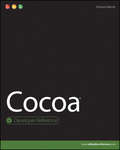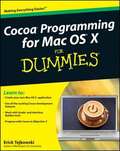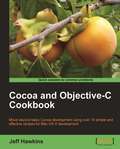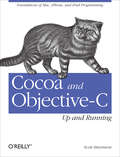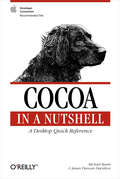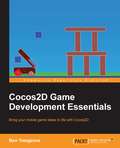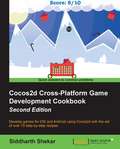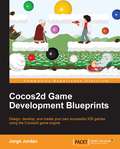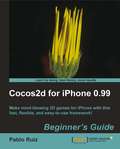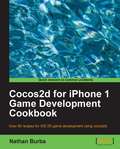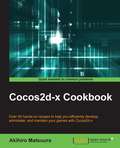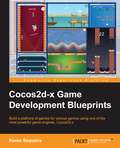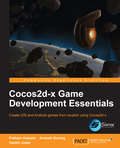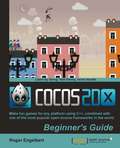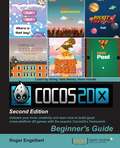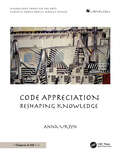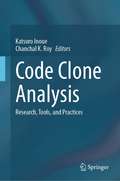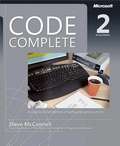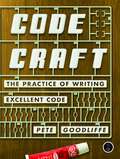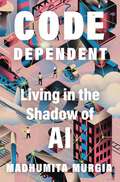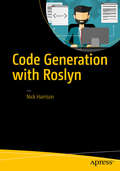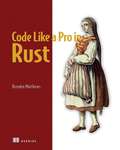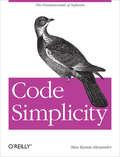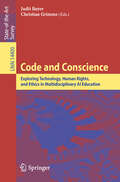- Table View
- List View
Cocoa
by Richard WentkDevelop applications for Mac OS X with this Developer Reference guideMake a clean transition to programming in Apple environments using the elegant and dynamic programming API Cocoa and this practical guide. Written by aseasoned Mac expert, this book shows you how to write programs in Cocoa for the rapidly expanding world of Macintosh users.Part of the Developer Reference series, this book prepares you for a productive programming experience on today's fastest-growing platform.Cocoa is a programming framework for developing in Apple environments, including Mac OS X 10.6 Snow LeopardThis book covers all the major information you need to start developing dynamic applications for Mac OS XMaster all Cocoa tools, including Xcode and working with Objective-CIncludes full coverage of the Cocoa API, Xcode, and Objective-C, as well as programming for Apple's latest OS X, Snow LeopardCompanion Web site includes all code filesProgramming for Apple's Macintosh is a growing career field. This essential guide, one of the most comprehensive on Cocoa, will help you quickly become productive.
Cocoa Programming for Mac OS X For Dummies
by Erick TejkowskiCocoa programming is not only the favored development environment for Mac OS X, it's also a primary tool for creating iPhone and iPod Touch software. That makes this a great time to learn Cocoa, and Cocoa Programming for Mac OS X For Dummies is the ideal place to start!This book gives you a solid foundation in Cocoa and the unusual syntax of Objective-C. You'll learn what's new in Cocoa frameworks and create an application step by step. For example, you can:See how Xcode underlies your applications as the main component of Apple's IDEExamine the basics of the Objective-C language, the elements of a Cocoa interface, and object-oriented programmingUse Xcode and Interface BuilderSpruce up your apps with audio, video, Internet features, stylized text, and moreCreate applications with the stunning graphics for which Macs are famousSee how to build apps with multiple documents and even executables that aren't traditional Mac appsUse all the exciting new Cocoa featuresWork with Cocoa numbers, arrays, Booleans, and datesBuild document-based applicationsSimplify with key-value codingThe better you understand Cocoa programming, the better the applications you can create for Mac OS X, iPhone, and iPod Touch. Cocoa Programming for Mac OS X For Dummies makes it easy and fun!Note: CD-ROM/DVD and other supplementary materials are not included as part of eBook file.
Cocoa Touch for iPhone OS 3
by Jiva DevoeJoin the gold rush to developing cool iPhone apps with this complete iPhone OS 3 developer's guide. Professional developer Jiva DeVoe speaks your language, and he talks you through the entire process--from explaining Cocoa Touch and the iPhone SDK to using Xcode and the Game Kit API. Follow step-by-step tutorials, then apply practical tips on signing and selling your applications. Even if you're new to iPhone development you'll soon be cranking out great code. Walk through Xcode, Interface Builder, and other key toolsBuild simple or complex GUIs with navigation and custom viewsImplement a database with Core Data, and design your schema in XcodeLearn to use the iPhone's signature multi-touch capabilities in your applicationsWork with the Apple Push Notification ServiceUse the Map Kit API to create apps with embedded mapsRecord audio, play video, and access the iPod LibrarySet up your developer certificates and code sign your appsUse Store Kit to sell expanded features and content within your appsWhether you're a new iPhone developer or seasoned veteran, this book is the perfect go-to reference for iPhone development-and one of an exciting new series for Apple developers.Note: CD-ROM/DVD and other supplementary materials are not included as part of eBook file.
Cocoa and Objective-C Cookbook
by Jeff HawkinsWritten in a cookbook style, this book offers solutions using a recipe-based approach. Each recipe contains step-by-step instructions followed by an analysis of what was done in each task and other useful information. The cookbook approach means you can dive into whatever recipes you want in no particular order. This book is perfect for the Mac OS X Cocoa developer who is ready to move beyond the basics and dive into more advanced Cocoa topics. The cookbook format lets you jump right into the examples without the lengthy explanations you often find in other books. Basic familiarity with Cocoa and Objective-C development is required.
Cocoa and Objective-C: Foundations of Mac, iPhone, and iPad Programming
by Scott StevensonBuild solid applications for Mac OS X, iPhone, and iPod Touch, regardless of whether you have basic programming skills or years of programming experience. With this book, you'll learn how to use Apple's Cocoa framework and the Objective-C language through step-by-step tutorials, hands-on exercises, clear examples, and sound advice from a Cocoa expert.Cocoa and Objective-C: Up and Running offers just enough theory to ground you, then shows you how to use Apple's rapid development tools -- Xcode and Interface Builder -- to develop Cocoa applications, manage user interaction, create great UIs, and more. You'll quickly gain the experience you need to develop sophisticated Apple software, whether you're somewhat new to programming or just new to this platform.Get a quick hands-on tour of basic programming skills with the C languageLearn how to use Interface Builder to quickly design and prototype your application's user interfaceStart using Objective-C by creating objects and learning memory managementLearn about the Model-View-Controller (MVC) method of sharing data between objectsUnderstand the Foundation value classes, Cocoa's robust API for storing common data typesBecome familiar with Apple's graphics frameworks, and learn how to make custom views with AppKit
Cocoa in a Nutshell: A Desktop Quick Reference
by Michael Beam James Duncan DavidsonCocoa® is more than just a collection of classes, and is certainly more than a simple framework. Cocoa is a complete API set, class library, framework, and development environment for building applications and tools to run on Mac OS® X. With over 240 classes, Cocoa is divided into two essential frameworks: Foundation and Application Kit. Above all else, Cocoa is a toolkit for creating Mac OS X application interfaces, and it provides access to all of the standard Aqua® interface components such as menus, toolbars, windows, buttons, to name a few.Cocoa in a Nutshell begins with a complete overview of Cocoa's object classes. It provides developers who may be experienced with other application toolkits the grounding they'll need to start developing Cocoa applications. Common programming tasks are described, and many chapters focus on the larger patterns in the frameworks so developers can understand the larger relationships between the classes in Cocoa, which is essential to using the framework effectively.Cocoa in a Nutshell is divided into two parts, with the first part providing a series of overview chapters that describe specific features of the Cocoa frameworks. Information you'll find in Part I includes:An overview of the Objective-C languageCoverage of the Foundation and Application Kit frameworksOverviews of Cocoa's drawing and text handling classesNetwork services such as hosts, Rendezvous URL services, sockets, and file handlingDistributed notifications and distributed objects for interapplication communicationExtending Cocoa applications with other frameworks, including the AddressBook, DiscRecording, and Messaging frameworksThe second half of the book is a detailed quick reference to Cocoa's Foundation and Application Kit (AppKit) classes. A complement to Apple's documentation, Cocoa in a Nutshell is the only reference to the classes, functions, types, constants, protocols, and methods that make up Cocoa's Foundation and Application Kit frameworks, based on the Jaguar release (Mac OS X 10.2). Peer-reviewed and approved by Apple's engineers to be part of the Apple Developer Connection (ADC) Series, Cocoa in a Nutshell is the book developers will want close at hand as they work. It's the desktop quick reference they can keep by their side to look something up quickly without leaving their work.Cocoa in a Nutshell is the book developers will want close at hand as they work. It's the desktop quick reference they can keep by their side to look something up quickly without leaving their work.
Cocos2D Game Development Essentials
by Ben TrengroveIf you are a game developer with experience in Objective-C and are interested in creating games for iOS or Android, this is the book for you. It will help you to quickly get started with Cocos2D and guide you through the process of creating a game, giving you the essential skills and knowledge you need to do so.
Cocos2d Cross-Platform Game Development Cookbook - Second Edition
by Siddharth ShekarDevelop games for iOS and Android using Cocos2d with the aid of over 70 step-by-step recipes About This Book * Learn to efficiently use Cocos2d to develop cross-platform games, and have them work on iOS as well as Android * Get acquainted with industry-wide professional tools such as Glyph Designer, Texture Packer, and Physics Editor, as well as using the Swift/ Sprite builder implementation of Cocos2d * Use the easy-to-follow recipes to develop as well as deploy games to the Playstore and the App Store Who This Book Is For This book is for intermediate game developers and especially the ones who are generally curious to find out what's new in Cocos2d v 3.3. What You Will Learn * Build custom sprites with custom animations for the game * Build interactivity into your game by adding gestures and touch interactions * Understand AI enemy programming and path finding to make games more exciting * Add physics to your game to make it more lively and interactive * Get familiar with the Swift and Sprite builder implementations along with Objective-C programming * Perform hassle-free deployment of games built in iOS onto Android * Add effects and particle systems to make the game more colorful In Detail Cocos2d is the world's leading game development framework for developing iOS games. With the introduction of Swift and Spritebuilder, it has become easier than ever to develop the games of your dreams without much effort. With Cocos2d, you can also deploy the game on Android, thereby maximizing profit and reducing development and porting costs. The book starts off with a detailed look at how to implement sprites and animations into your game to make it livelier. You will then learn to add scenes to the game such as the gameplay scene and options scene and create menus and buttons in these scenes, as well as creating transitions between them. From there on, you will get an understanding of how to program user interactions such as tapping, holding, and swiping. You'll then add accelerometer inputs and physics to the scene, and make objects respond back to the inputs. A game is practically incomplete without audio being added, so this will be covered next. The next section will include ways to add Artificial Intelligence to enemies in the game, allowing them to patrol, chase, and shoot in a projectile manner. You will then learn to use NSUserDefault to save and load game progress, and create and access files using JSON, Plist, and XML files for custom storage and retrieval of data. Then you will learn to add dynamic lighting to your game and will use industry-wide tools such as Texture Packer, Glyph Designer, Physics Editor, Particle Designer, and Sprite Illuminator to create more visually appealing and performance-optimized games. Towards the end of the book, we dive into Apple's latest programming language--Swift, highlighting the major differences between Objective C and Swift. The book culminates with taking your existing game developed for iOS and porting it to Android, showing you how to install the Android Xcode plugin as well. Style and approach The book is written in an extremely lucid and step-by-step manner; it can be understood easily by anyone. The topics included are broken down into individual chapters so you can refer to the specific chapter to get answers on the subject you are interested in.
Cocos2d Game Development Blueprints
by Jorge JordánWhether you are a passionate gamer, like developing, or are just curious about game development, this book is for you. The book has been written to teach 2D game development to app developers and to teach Objective-C to game developers, as learning Cocos2d is the perfect step for both roles.
Cocos2d for iPhone 0.99 Beginner's Guide
by Pablo RuizThis is a beginner's guide.If you want to get into the iPhone industry and have your games compete with the best, this book is for you. You should have some basic programming experience with Objective-C and a good understanding of OOP. A little experience of game programming in any language is welcome but not a must.
Cocos2d for iPhone 1 Game Development Cookbook
by Nathan BurbaThis book is full of fun and engaging recipes with modular libraries that can be plugged into your project. Each recipe consists of explained code accompanied by screenshots for your understanding. If you want to elevate your basic Cocos2d project to the next level, this is the book for you. Some understanding of Objective-C and Cocos2d is recommended. People with some programming experience may also find this book useful.
Cocos2d-x Cookbook
by Akihiro MatsuuraOver 50 hands-on recipes to help you efficiently administer and maintain your games with Cocos2d-xAbout This BookBuild exciting games, apps, and other cross-platform GUI based interactive programs with Cocos2d-xExplore the nitty-gritty of the latest Cocos2d-x on the block, version 3.6A step-by-step guide that shows you the functionalities of Cocos2d-x followed by an explanation of how they workWho This Book Is ForIf you are a game developer and want to learn more about cross-platform game development in Cocos2d-x, then this book is for you. Knowledge of C++, Xcode, Eclipse, and how to use commands in the terminal are prerequisites for this book.What You Will LearnInstall and set up Cocos2d-x for your development environmentBuild, test, and release game applications for iOS and AndroidDevelop your games for multiple platformsCustomize Cocos2d-x for your gamesUse a physical engine in your gamesSave and load text, JSON, XML, or other formatsExplore the brand new features of Cocos2d-xIn DetailCocos2d-x is a suite of open source, cross-platform game-development tools used by thousands of developers all over the world. Cocos2d-x is a game framework written in C++, with a thin platform-dependent layer. Completely written in C++, the core engine has the smallest footprint and the fastest speed of any other game engine, and is optimized to be run on all kinds of devices.You will begin with the initial setup and installation of Cocos2d before moving on to the fundamentals needed to create a new project. You will then explore and create the sprites, animations, and actions that you will include in the game. Next you will look at strings and create labels, including a label with True Type Font (TTF) font support.Later, you will learn about layer and scene creation and transition. Then you will create the GUI parts essential for a game, such as buttons and switches. After that, you will breathe life into the game with background music and sound effects using the all new Cocos2d-x audio engine. You will then discover how to manage resource files and implement processes that depend on the operating system.Finally, you will polish your game with physics such as gravity and elevation, learn about tools that will help you make games more robust and stable, and get to know best practices to improve the game you have developed.Style and approachThis book is an easy-to-follow guide with ample recipes to help you better understand Cocos2d-x.
Cocos2d-x Game Development Blueprints
by Karan SequeiraIf you are a proficient Cocos2d game developer who wants to enhance his or her game development skill set using Cocos2d-x to build different types of games, this book is for you.
Cocos2d-x Game Development Essentials
by Gareth Jones Arutosh Gurung Frahaan HussainThis book is designed to help existing developers who are looking to learn this amazing framework, which provides cross-platform development. It is also perfect for developers who already have an existing C++ foundation and would like to learn game development using Cocos2d-x, or those who are coming from another framework.
Cocos2d-x by Example Beginner's Guide
by Roger EngelbertGet to grips with Cocos2D-X using step-by-step examples. Roger Engelbert will have you smiling throughout and learning valuable information at every turn.If you have brilliant ideas for amazing games and want to bring them to life, then this book is what you need. Work through easy-to-follow examples and learn exactly what you need to know to make your games a reality.No programming experience necessary!
Cocos2d-x by Example: Beginner's Guide - Second Edition
by Roger EngelbertIf you are a game enthusiast who would like to develop and publish your own game ideas onto different app stores, this is the book for you. Some knowledge of C++ or Java is helpful but not necessary.
Code Appreciation: Reshaping Knowledge
by Anna UrsynLike art appreciation and music appreciation, this code appreciation book invites the readers to look relaxedly into major programming concepts used in many disciplines through short stories set in alphabetical order. Some students fear technology with programming behind it, and shy away from the word "coding." Coding has become common and needed, and these stories are set to help non-coders lose their inhibition. It also might help with prompt writing. Many employers seek employees with experience in visual communication, technology, and storytelling skills. Most tasks are created through group efforts, so a better grasp of what other co-workers are doing speeds up the process.The book offers a new approach to storytelling by weaving coding into stories. Playfully, it encourages the readers to see computing as easier to understand and present in most disciplines. The book might benefit high school and middle school students, faculty, advisors, chancellors, and those seeking majors or passions. People interested in computer graphics, arts, graphic design, computer science, and others may gain a general understanding of how technology affects various disciplines and how everything is connected.This book is a part of the “Knowledge Through the Arts” series, consisting of:Dance Code — Dance Steps as a CodeNew Storytelling — Learning Through MetaphorsCode Appreciation — Reshaping KnowledgeNature Appreciation — Knowledge as Art
Code Clone Analysis: Research, Tools, and Practices
by Katsuro Inoue Chanchal K. RoyThis is the first book organized around code clone analysis. To cover the broad studies of code clone analysis, this book selects past research results that are important to the progress of the field and updates them with new results and future directions. The first chapter provides an introduction for readers who are inexperienced in the foundation of code clone analysis, defines clones and related terms, and discusses the classification of clones. The chapters that follow are categorized into three main parts to present 1) major tools for code clone analysis, 2) fundamental topics such as evaluation benchmarks, clone visualization, code clone searches, and code similarities, and 3) applications to actual problems. Each chapter includes a valuable reference list that will help readers to achieve a comprehensive understanding of this diverse field and to catch up with the latest research results. Code clone analysis relies heavily on computer science theories such as pattern matching algorithms, computer language, and software metrics. Consequently, code clone analysis can be applied to a variety of real-world tasks in software development and maintenance such as bug finding and program refactoring. This book will also be useful in designing an effective curriculum that combines theory and application of code clone analysis in university software engineering courses.
Code Complete
by Steve McconnellWidely considered one of the best practical guides to programming, Steve McConnell's original CODE COMPLETE has been helping developers write better software for more than a decade. Now this classic book has been fully updated and revised with leading-edge practices--and hundreds of new code samples--illustrating the art and science of software construction. Capturing the body of knowledge available from research, academia, and everyday commercial practice, McConnell synthesizes the most effective techniques and must-know principles into clear, pragmatic guidance. No matter what your experience level, development environment, or project size, this book will inform and stimulate your thinking--and help you build the highest quality code. Discover the timeless techniques and strategies that help you: Design for minimum complexity and maximum creativity Reap the benefits of collaborative development Apply defensive programming techniques to reduce and flush out errors Exploit opportunities to refactor--or evolve--code, and do it safely Use construction practices that are right-weight for your project Debug problems quickly and effectively Resolve critical construction issues early and correctly Build quality into the beginning, middle, and end of your project
Code Craft: The Practice of Writing Excellent Code
by Pete GoodliffeYou know how to write code that works, but what about code that's well written and easy to understand? And robust and bug-free? If other programmers looked at your handiwork, would they be able to figure out the code's logic and purpose? Exceptional programmers have more than just technical know-how; they adopt the right approach and attitude to development.Code Craft will help take your programming beyond writing correct code to writing great code, thus turning you into a true programming professional or enhancing your existing professional skills.With language-agnostic advice that's relevant to all developers, Code Craft covers code-writing concerns such as presentation style, variable naming, error handling, and security. And it tackles broader, real-world programming issues like effective teamwork, development processes, and documentation. Each chapter ends with a Q&A section that reviews key concepts to get you thinking like an expert, making it an especially great reference for newer programmers who want to work professionally and efficiently as part of a team.This survival guide for the software factory will show you how to:–Write good code when the world's not helping you–Avoid disasters and distractions in the workplace–Assess your abilities accurately and determine ways to improve–Adopt productive attitudes and follow best practicesThere's little more valuable than the advice of a true, programming professional. You'll find Code Craft to be clear, practical, and entertaining throughout, and a great way to take your code (and your career) to the next level.
Code Dependent: Living in the Shadow of AI
by Madhumita MurgiaShortlisted for the Women’s Prize for Non-FictionNamed a best book of the year by Esquire, The Spectator and Publishers WeeklyA riveting story of what it means to be human in a world changed by artificial intelligence, revealing the perils and inequities of our growing reliance on automated decision-makingOn the surface, a British poet, an UberEats courier in Pittsburgh, an Indian doctor, and a Chinese activist in exile have nothing in common. But they are in fact linked by a profound common experience—unexpected encounters with artificial intelligence. In Code Dependent, Murgia shows how automated systems are reshaping our lives all over the world, from technology that marks children as future criminals, to an app that is helping to give diagnoses to a remote tribal community. AI has already infiltrated our day-to-day, through language-generating chatbots like ChatGPT and social media. But it’s also affecting us in more insidious ways. It touches everything from our interpersonal relationships, to our kids’ education, work, finances, public services, and even our human rights.By highlighting the voices of ordinary people in places far removed from the cozy enclave of Silicon Valley, Code Dependent explores the impact of a set of powerful, flawed, and often-exploitative technologies on individuals, communities, and our wider society. Murgia exposes how AI can strip away our collective and individual sense of agency, and shatter our illusion of free will. The ways in which algorithms and their effects are governed over the coming years will profoundly impact us all. Yet we can’t agree on a common path forward. We cannot decide what preferences and morals we want to encode in these entities—or what controls we may want to impose on them. And thus, we are collectively relinquishing our moral authority to machines.In Code Dependent, Murgia not only sheds light on this chilling phenomenon, but also charts a path of resistance. AI is already changing what it means to be human, in ways large and small, and Murgia reveals what could happen if we fail to reclaim our humanity.
Code Generation with Roslyn
by Nick HarrisonLearn how Roslyn's new code generation capability will let you write software that is more concise, runs faster, and is easier to maintain. You will learn from real-world business applications to create better software by letting the computer write its own code based on your business logic already defined in lookup tables. Code Generation with Rosyln is the first book to cover this new capability. You will learn how these techniques can be used to simplify systems integration so that if one system already defines business logic through lookup tables, you can integrate a new system and share business logic by allowing the new system to write its own business logic based on already existing table-based business logic. One of the many benefits you will discover is that Roslyn uses an innovative approach to compiler design, opening up the inner workings of the compiler process. You will learn how to see the syntax tree that Roslyn is building as it compiles your code. Additionally, you will learn to feed it your own syntax tree that you create on the fly. What You'll Learn Structure logic to be stored in database design Build complex conditional logic based on lookup data in the database Compile code that you generate programmatically Discover generated code and run it dynamically to implement new business logic Debug problems in generated code Deploy and access generated code Who This Book Is For Back end developers in very dynamic fast-paced business environments. Developers focused on integrating different systems across an enterprise should also find this information useful.
Code Like a Pro in Rust
by Brenden MatthewsGet ready to code like a pro in Rust with insider techniques used by Rust veterans!Code Like a Pro in Rust dives deep into memory management, asynchronous programming, and the core Rust skills that make you a Rust pro! Plus, you&’ll find essential productivity techniques for Rust testing, tooling, and project management. You&’ll soon be writing high-quality code that needs way less maintenance overhead. In Code Like A Pro in Rust, you will learn: Essential Rust tooling Core Rust data structures Memory management Testing in Rust Asynchronous programming for Rust Optimized Rust Rust project management Code Like A Pro in Rust is a fast-track guide to building and delivering professional quality software in Rust. It skips the fluff and gets right to the heart of this powerful modern language. You&’ll learn how to sidestep common Rust pitfalls and navigate quirks you might never have seen before—even if you&’ve been programming for many years! Plus, discover timeless strategies for navigating the evolving Rust ecosystem and ensure your skills can easily adapt to future changes. About the technology Rust is famous for its safety, performance, and security, but it takes pro skills to make this powerful language shine. This book gets you up to speed fast, so you&’ll feel confident with low-level systems, web applications, asynchronous programming, concurrency, optimizations, and much more. About the book Code Like a Pro in Rust will make you a more productive Rust programmer. This example-rich book builds on your existing know-how by introducing Rust-specific design patterns, coding shortcuts, and veteran skills like asynchronous programming and integrating Rust with other languages. You&’ll also meet amazing Rust tools for testing, code analysis, and application lifecycle management. It&’s all the good stuff in one place! What's inside Core Rust data structures Memory management Creating effective APIs Rust tooling, testing, and more About the reader Assumes you know Rust basics. About the author Brenden Matthews is a software engineer, entrepreneur, and a prolific open source contributor who has been using Rust since the early days of the language. Table of Contents 1 Feelin&’ Rusty PART 1 2 Project management with Cargo 3 Rust tooling PART 2 4 Data structures 5 Working with memory PART 3 6 Unit testing 7 Integration testing PART 4 8 Async Rust 9 Building an HTTP REST API service 10 Building an HTTP REST API CLI PART 5 11 Optimizations
Code Simplicity: The Fundamentals of Software
by Max Kanat-AlexanderGood software design is simple and easy to understand. Unfortunately, the average computer program today is so complex that no one could possibly comprehend how all the code works. This concise guide helps you understand the fundamentals of good design through scientific laws—principles you can apply to any programming language or project from here to eternity.Whether you’re a junior programmer, senior software engineer, or non-technical manager, you’ll learn how to create a sound plan for your software project, and make better decisions about the pattern and structure of your system.Discover why good software design has become the missing scienceUnderstand the ultimate purpose of software and the goals of good designDetermine the value of your design now and in the futureExamine real-world examples that demonstrate how a system changes over timeCreate designs that allow for the most change in the environment with the least change in the softwareMake easier changes in the future by keeping your code simpler nowGain better knowledge of your software’s behavior with more accurate tests
Code and Conscience: Exploring Technology, Human Rights, and Ethics in Multidisciplinary AI Education (Lecture Notes in Computer Science #14400)
by Christian Grimme Judit BayerThis volume originated from an international, interdisciplinary research course organized by the Institute of Information Management of the University of Münster in 2021-2022, funded by the DAAD IVAC sponsorship program. The coauthors and their contributions represent different disciplines, fusing perspectives of law and information sciences. The contributions present current issues in AI, ethics and human rights, policing, privacy and surveillance, social media, and data protection. The book has a further mission: it offers insight into a novel educational format that combines an intercultural learning environment with interdisciplinary co-working, e-learning methods, peer education, and interactive group work.
